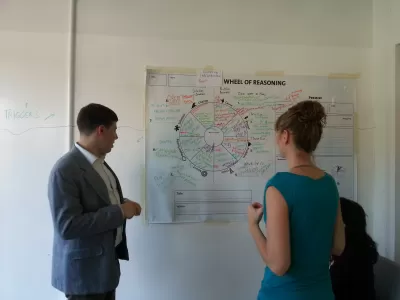The recent growth in civic innovation in city halls throughout the country has led to taxpayer investment in private sector organizations addressing social issues, but do these programs really lead to tangible, broad, citizen benefit?

(Updated 11/13/2014)
The federal government began pushing for innovations within the public sector in May 2009, when President Obama founded the White House Office of Social Innovation and Civic Participation (Office). Since then, innovation labs have created a lot of buzz, with "Offices of Civic Innovation" (or some variety) popping up in municipalities all over the country to tackle old problems with fresh perspectives. Some call them an "Offices of New Urban Mechanics," "Civic Innovation Departments," or in the case of Los Angeles, the visually provocative "Tech Bullpen."
As described by Clayton Christensen, a professor at the Harvard Business School who developed the term "disruptive innovation,” a successful office for social innovation should employ four main tactics to accomplish its mission. First, governments should invest "in innovations that are developed and identified by citizens outside of government who better understand the problems." Second, the office should support "'bottom-up' initiatives, in preference to 'trickle-down' philanthropy—because the societal impact of the former is typically greater." Third, Christensen argues that the office should utilize impact metrics to measure performance and, finally, that it should also invest in social innovation outside of the non-profit sector.
Los Angeles' most recent citizen-driven social innovation initiative, the Civic Innovation Lab, is an 11-month project aimed at prototyping new solutions for issues within the city of Los Angeles. It is supported by the HubLA, Learn Do Share, the Los Angeles *City Tech Bullpen, and Innovate LA, a membership organization within the Los Angeles County Economic Development Corporation. Private and public sector support for such labs, in one of the largest cities in America, is highly unprecedented, and because this initiative in Los Angeles is a new mechanism explicitly supported by the public sector, it warrants a critical check on its motivations and accomplishments. Depending on its success, the Civic Innovation Lab could serve as a model for future municipalities.
The Los Angeles Civic Innovation Lab operates in three main phases: 1) workshops where citizens learn about the possibilities of Open Data and discuss what deep challenges face Los Angeles (called the “Discover, Define, Design” stage), 2) a call for solutions to solve the design challenges brought to light in the first phase, and 3) a six-month accelerator program to prototype selected solutions. I participated in the most recent Civic Innovation Lab session, a three-day workshop concluding the “Discover, Define, Design” phase.
In the first phase, I participated in two original exercises that established a common working knowledge among participants. First, we underwent the “World Cafe” for the four main issues facing Los Angeles today as raised by a previous “Discover, Define, Design” workshop: community (connections between and within communities), civic administration, social (homelessness, gentrification, affordable housing), and transportation. Five participants gathered around tables representing a category, wrote ideas regarding the current and future state of the issue, and discussed. In the end, each table was covered with a massive cause and effect web.
The World Cafe aided us in our next exercise, "The Wheel of Reason," where we traced the evolution of not-so-distant problems facing Los Angeles. My group discussed the causes of Los Angeles' crumbing streets and pipes. By looking backward, we pinpointed Proposition 13 as a hindrance to timely infrastructure maintenance and proposed a reform campaign to create a more efficient and effective budgeting process. These two new tools framed the conversation for future discussion on the root problems we wanted to address through the Requests for Solutions (RFS).
But ultimately, the participants did not write the final RFS. The Civic Innovation Lab founding partners will take notes from these three days into account when they write the formal RFS. But to what degree will these founding partners incorporate the challenges and selection criteria discussed by citizens into their RFS? The Civic Innovation Lab neither specified their procedures for writing the RFS nor presented any methodology for accountability.
It is also unclear whether the Los Angeles Civic Innovation Lab will invest in disruptive bottom-up initiatives. Christensen outlines these disruptive technologies as enabling "a larger population of people who previously had limited access to expensive services to now enjoy them." Within the six-month program, can the Civic Innovation Lab empower a broad spectrum of Los Angeles residents to participate in quality of life improvements? Or, given the limited time frame, will they create something that expedites deliveries of civic services for residents already benefitting from the city's best services?
Moreover, the structure of the lab allocates equal amounts of time (three months each) toward solution prototyping and business modeling. In discussing the challenges and opportunities of similar civic innovation groups with leaders from Open Austin, Chicago's CivicLab, and Open Oakland, many complex projects take six months or more to come to fruition. Three months is simply not enough time to build relationships, research the various issues, develop a strategy, organize, and create multiple prototyped products.
Utilizing performance metrics is a crucial step in innovation. While the Civic Innovation Lab does not explicitly state whether they will measure the performance of prototyped solutions within the accelerator program, such evaluations could be easily implemented. As it plays such a critical part in Mayor Eric Garcetti's "culture of innovation," performance monitoring will likely be incorporated into the Civic Innovation Lab. However, at this time none of the rhetoric used by the Civic Innovation Lab discusses performance metrics, so the lab should incorporate these aspects for better accountability and transparency.
Christensen also recommends that governmental civic innovation bodies consider organizations outside of the non-profit sphere as potential innovators prime for investment. The Los Angeles Civic Innovation Lab is very open about who can apply—new startups, non-profits, and existing innovation teams within companies—to the "Call for Solutions" phase, allowing a wide range of innovators to be considered for potential funding.
The inclusive nature of the event created a safe space for citizens from all walks of life and neighborhoods to raise many poignant challenges through casual conversation and structured workshops. This new model is not perfect though. Moving forward, the Los Angeles Civic Innovation Lab, or any similar future endeavor, should wholly base their "Requests for Solutions" on participant's ideas, expand the startup incubator phase time-frame to nine months (with six months for the prototyping phase), and implement performance metrics, to ensure that the lab’s accomplishments broadly serve all residents.
Updated 11/13/2014: The story was updated to correctly describe the Tech Bullpen as a Los Angeles City, not a Los Angeles County, organization.

Manufactured Crisis: Losing the Nation’s Largest Source of Unsubsidized Affordable Housing
Manufactured housing communities have long been an affordable housing option for millions of people living in the U.S., but that affordability is disappearing rapidly. How did we get here?

Americans May Be Stuck — But Why?
Americans are moving a lot less than they once did, and that is a problem. While Yoni Applebaum, in his highly-publicized article Stuck, gets the reasons badly wrong, it's still important to ask: why are we moving so much less than before?

Using Old Oil and Gas Wells for Green Energy Storage
Penn State researchers have found that repurposing abandoned oil and gas wells for geothermal-assisted compressed-air energy storage can boost efficiency, reduce environmental risks, and support clean energy and job transitions.

Greening Oakland’s School Grounds
With help from community partners like the Trust for Public Land, Oakland Unified School District is turning barren, asphalt-covered schoolyards into vibrant, green spaces that support outdoor learning, play, and student well-being.

California Governor Suspends CEQA Reviews for Utilities in Fire Areas
Utility restoration efforts in areas affected by the January wildfires in Los Angeles will be exempt from environmental regulations to speed up the rebuilding of essential infrastructure.

Native American Communities Prepare to Lead on Environmental Stewardship
In the face of federal threats to public lands and conservation efforts, indigenous groups continue to model nature-centered conservation efforts.
Urban Design for Planners 1: Software Tools
This six-course series explores essential urban design concepts using open source software and equips planners with the tools they need to participate fully in the urban design process.
Planning for Universal Design
Learn the tools for implementing Universal Design in planning regulations.
Heyer Gruel & Associates PA
City of Moreno Valley
Institute for Housing and Urban Development Studies (IHS)
City of Grandview
Harvard GSD Executive Education
Salt Lake City
NYU Wagner Graduate School of Public Service
City of Cambridge, Maryland






























